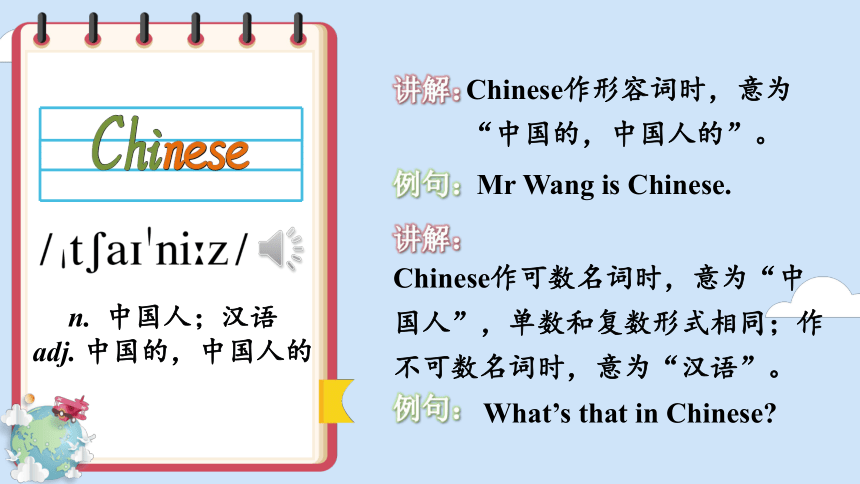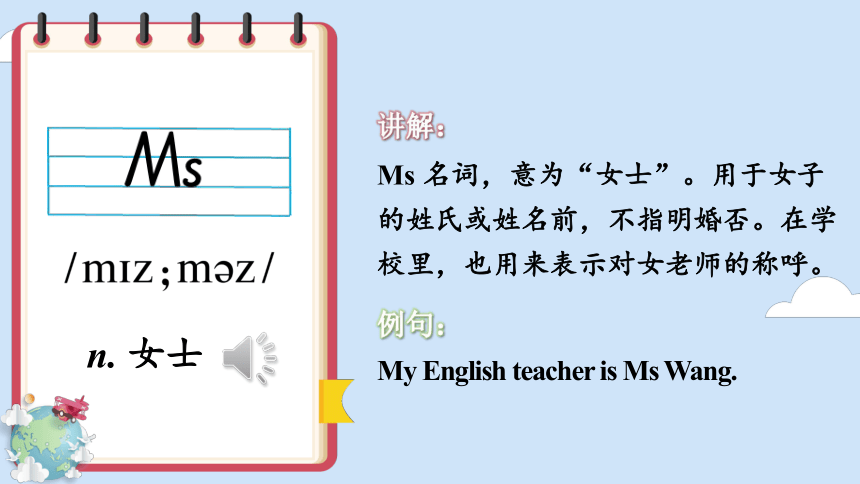Module 1 My classmate单词讲解课件(共29张PPT)
文档属性
| 名称 | Module 1 My classmate单词讲解课件(共29张PPT) |  | |
| 格式 | zip | ||
| 文件大小 | 28.8MB | ||
| 资源类型 | 教案 | ||
| 版本资源 | 外研版 | ||
| 科目 | 英语 | ||
| 更新时间 | 2022-08-03 17:16:04 | ||
图片预览









文档简介
(共29张PPT)
Module 1 My classmates
Unit 1 Nice to meet you.
外研·七年级上册
Chinese作可数名词时,意为“中国人”,单数和复数形式相同;作不可数名词时,意为“汉语”。
What’s that in Chinese
n. 中国人;汉语
adj. 中国的,中国人的
讲解:
Chinese作形容词时,意为“中国的,中国人的”。
Mr Wang is Chinese.
例句:
讲解:
例句:
讲解:
from为介词,后面一般接表示国家或地点的词。
短语:
be from = come from
来自……;是……人
prep. 从……来,来自
例句:
He is from Beijing.
=He comes from Beijing.
例句:
讲解:
where疑问副词,意为“在哪里,去哪里”,用来引导特殊疑问句,对地点进行提问。
—Where is her cat
—It is on the chair.
adv. 在哪里,去哪里
注意:
where is可缩写为where’s, 但where are不能缩写;
例句:
I’m thirteen years old.
n. 年龄;年
拓展:
about 还可作副词,意为“大约”。
Tom is about fifteen years old.
例句:
This is a book about China.
prep. 关于
n. 女士
Ms 名词,意为“女士”。用于女子的姓氏或姓名前,不指明婚否。在学校里,也用来表示对女老师的称呼。
例句:
My English teacher is Ms Wang.
讲解:
America是名词,意为“美国;美洲”。美国也可称为USA或US。
例句:
Three Americans are studying American history in America.
讲解:
美国;美洲
拓展:
American adj. 美国的;美国人的;美洲的 n.美国人;美洲人
例句:
He is not a student.
adv. 不,不是,没有
注意:
is not可缩写为isn’t;are not可缩写为aren’t,但am not不能缩写。
辨析:not与no
not adv.不,不是,没有。常用于be动词(am,is,are)、助动词或情态动词之后,帮助构成否定句,不能单独使用。
no adj.没有;无。其后可接可数名词,也可接不可数名词。
adv.不,不是;没有。常用于一般疑问句或反意疑问句的否定回答,可以单独使用,反义词是yes。
例句:
He is from England.
英格兰
例句:
Hi! How are you doing
int. 嘿,喂
讲解:
(1)American作形容词,意为“美国的;美国人的;美洲的”,一般在句中作表语或定语。
(2)American还可用作可数名词,意为“美国人;美洲人”,其复数形式为Americans。
例句:
An American student is in the classroom.
n. 美国人;美洲人
adj. 美国的;美国人的;美洲的
讲解:
our形容词性物主代词,意为“我们的”,在句中作定语,后面必须接名词,不能单独使用。
例句:
She is our teacher.
pron. 我们的
拓展:
we pron. 我们(主格)us pron. 我们(宾格)
拓展:
Sarah is in Grade Three.
例句:
grade作名词,还可意为“成绩等级;评分等级”,其复数形式为grades。
Study hard, and you will get good grades.
n. 年级
pron. 他
讲解:
he人称代词主格形式,意为“他”,指单个男性,对应词是she,意为“她”。当she或he作主语时,后面的系动词be用is。
拓展:
his pron. 他的(形容词性物主代词)
例句:
He is Tom.
Mr Smith is in China.
讲解:
例句:
China是专有名词,意为“中国”。作“中国”讲时,首字母要大写。
中国
拓展:
Chinese adj. 中国的;中国人的
n. 中国人;汉语
Module 1 My classmates
Unit 2 I’m Wang Lingling and I’m thirteen years old.
外研·七年级上册
讲解:
everyone不定代词,意为“大家;每人”,作主语时,谓语动词用第三人称单数形式。
例句:
Everyone is happy.
pron. 大家;每人
the capital of…意为“……的首都/省会
短语:
n. 首都;省会
Beijing is the capital of China.
例句:
capital还可作形容词,意为“大写的”。
Do you know this capital letter
拓展:
图解:
capital n. 首都
capital
adj. 大写的
讲解:
but连词,意为“但是,然而”,可以连接两个并列成分,表示前后意义上的转折关系或两种情况的对比。
conj. 但是,然而
辨析:but与and
but 但是,然而。表示转折关系
I know his name, but I don’t know his telephone number.
and 和,与。表示并列或顺承关系
The cat is white and the dog is black.
讲解:
very副词,意为“很,非常”,通常用来修饰形容词或副词,表示程度。
adv. 很,非常
例句:
It is very cold today.
拓展:
very much意为“很,非常”,是副词短语,常修饰动词,通常置于句末。very不能修饰动词。
small adj. 小的
反义词:
Beijing is very big.
We have a very big classroom.
例句:
adj. 大的
Shanghai is a very big city.
例句:
短语:
a very big city 一个非常大的城市
n. 城市
例句:
反义词:
big adj. 大的
That dress is too small for you.
adj. 小的
反义词:
例句:
This is my first day at school.
Can you say it first
last adj. 最后的,最末的
adj. 第一(位)的,首要的
adv. 先;首先
短语:
first name = given name 名字
讲解:
first name = given name 名字
例句:
Tony is my first name.
名字
例句:
Saturday is the last day of a week.
Please spell it last.
拓展:
last v. 持续
The meeting lasts two hours.
adj. 最后的,最末的 adv. 最后,最末
短语:
last name = family name 姓
讲解:
last name = family name 姓
例句:
Smith is my last name.
姓
pron. 每个,全体
讲解:
all作代词,意为“每个,全体”,在句中可作主语、宾语或同位语。
例句:
All is here.
She can spell all of the words.
拓展:
all还可作形容词,意为“全部的;所有的”,表示三者或三者以上的人或事物,修饰可数名词或不可数名词。
All the flowers are nice.
Module 1 My classmates
Unit 1 Nice to meet you.
外研·七年级上册
Chinese作可数名词时,意为“中国人”,单数和复数形式相同;作不可数名词时,意为“汉语”。
What’s that in Chinese
n. 中国人;汉语
adj. 中国的,中国人的
讲解:
Chinese作形容词时,意为“中国的,中国人的”。
Mr Wang is Chinese.
例句:
讲解:
例句:
讲解:
from为介词,后面一般接表示国家或地点的词。
短语:
be from = come from
来自……;是……人
prep. 从……来,来自
例句:
He is from Beijing.
=He comes from Beijing.
例句:
讲解:
where疑问副词,意为“在哪里,去哪里”,用来引导特殊疑问句,对地点进行提问。
—Where is her cat
—It is on the chair.
adv. 在哪里,去哪里
注意:
where is可缩写为where’s, 但where are不能缩写;
例句:
I’m thirteen years old.
n. 年龄;年
拓展:
about 还可作副词,意为“大约”。
Tom is about fifteen years old.
例句:
This is a book about China.
prep. 关于
n. 女士
Ms 名词,意为“女士”。用于女子的姓氏或姓名前,不指明婚否。在学校里,也用来表示对女老师的称呼。
例句:
My English teacher is Ms Wang.
讲解:
America是名词,意为“美国;美洲”。美国也可称为USA或US。
例句:
Three Americans are studying American history in America.
讲解:
美国;美洲
拓展:
American adj. 美国的;美国人的;美洲的 n.美国人;美洲人
例句:
He is not a student.
adv. 不,不是,没有
注意:
is not可缩写为isn’t;are not可缩写为aren’t,但am not不能缩写。
辨析:not与no
not adv.不,不是,没有。常用于be动词(am,is,are)、助动词或情态动词之后,帮助构成否定句,不能单独使用。
no adj.没有;无。其后可接可数名词,也可接不可数名词。
adv.不,不是;没有。常用于一般疑问句或反意疑问句的否定回答,可以单独使用,反义词是yes。
例句:
He is from England.
英格兰
例句:
Hi! How are you doing
int. 嘿,喂
讲解:
(1)American作形容词,意为“美国的;美国人的;美洲的”,一般在句中作表语或定语。
(2)American还可用作可数名词,意为“美国人;美洲人”,其复数形式为Americans。
例句:
An American student is in the classroom.
n. 美国人;美洲人
adj. 美国的;美国人的;美洲的
讲解:
our形容词性物主代词,意为“我们的”,在句中作定语,后面必须接名词,不能单独使用。
例句:
She is our teacher.
pron. 我们的
拓展:
we pron. 我们(主格)us pron. 我们(宾格)
拓展:
Sarah is in Grade Three.
例句:
grade作名词,还可意为“成绩等级;评分等级”,其复数形式为grades。
Study hard, and you will get good grades.
n. 年级
pron. 他
讲解:
he人称代词主格形式,意为“他”,指单个男性,对应词是she,意为“她”。当she或he作主语时,后面的系动词be用is。
拓展:
his pron. 他的(形容词性物主代词)
例句:
He is Tom.
Mr Smith is in China.
讲解:
例句:
China是专有名词,意为“中国”。作“中国”讲时,首字母要大写。
中国
拓展:
Chinese adj. 中国的;中国人的
n. 中国人;汉语
Module 1 My classmates
Unit 2 I’m Wang Lingling and I’m thirteen years old.
外研·七年级上册
讲解:
everyone不定代词,意为“大家;每人”,作主语时,谓语动词用第三人称单数形式。
例句:
Everyone is happy.
pron. 大家;每人
the capital of…意为“……的首都/省会
短语:
n. 首都;省会
Beijing is the capital of China.
例句:
capital还可作形容词,意为“大写的”。
Do you know this capital letter
拓展:
图解:
capital n. 首都
capital
adj. 大写的
讲解:
but连词,意为“但是,然而”,可以连接两个并列成分,表示前后意义上的转折关系或两种情况的对比。
conj. 但是,然而
辨析:but与and
but 但是,然而。表示转折关系
I know his name, but I don’t know his telephone number.
and 和,与。表示并列或顺承关系
The cat is white and the dog is black.
讲解:
very副词,意为“很,非常”,通常用来修饰形容词或副词,表示程度。
adv. 很,非常
例句:
It is very cold today.
拓展:
very much意为“很,非常”,是副词短语,常修饰动词,通常置于句末。very不能修饰动词。
small adj. 小的
反义词:
Beijing is very big.
We have a very big classroom.
例句:
adj. 大的
Shanghai is a very big city.
例句:
短语:
a very big city 一个非常大的城市
n. 城市
例句:
反义词:
big adj. 大的
That dress is too small for you.
adj. 小的
反义词:
例句:
This is my first day at school.
Can you say it first
last adj. 最后的,最末的
adj. 第一(位)的,首要的
adv. 先;首先
短语:
first name = given name 名字
讲解:
first name = given name 名字
例句:
Tony is my first name.
名字
例句:
Saturday is the last day of a week.
Please spell it last.
拓展:
last v. 持续
The meeting lasts two hours.
adj. 最后的,最末的 adv. 最后,最末
短语:
last name = family name 姓
讲解:
last name = family name 姓
例句:
Smith is my last name.
姓
pron. 每个,全体
讲解:
all作代词,意为“每个,全体”,在句中可作主语、宾语或同位语。
例句:
All is here.
She can spell all of the words.
拓展:
all还可作形容词,意为“全部的;所有的”,表示三者或三者以上的人或事物,修饰可数名词或不可数名词。
All the flowers are nice.
同课章节目录
- Starte
- Module 1 My teacher and my friends
- Module 2 My English lesson
- Module 3 My English book
- Module 4 My everyday life
- Module 1 My classmates
- Unit 1 Nice to meet you.
- Unit 2 I'm Wang Lingling and I'm thirteen years ol
- Unit 3 Language in use.
- Module 2 My family
- Unit 1 Is this your mum?
- Unit 2 These are my parents.
- Unit 3 Language in use.
- Module 3 My school
- Unit 1 There are thirty students in my class.
- Unit 2 The library is on the left of the playgroun
- Unit 3 Language in use.
- Module 4 Healthy food
- Unit 1 We've got lots of apples.
- Unit 2 Is your food and drink healthy?
- Unit 3 Language in use.
- Module 5 My school day
- Unit 1 I love history.
- Unit 2 We start work at nine o'clock.
- Unit 3 Language in use.
- Revision module A
- Module 6 A trip to the zoo
- Unit 1 Does it eat meat?
- Unit 2 The tiger lives in Asia.
- Unit 3 Language in use.
- Module 7 Computers
- Unit 1 How do I write my homework on the computer?
- Unit 2 When do you use a computer?
- Unit 3 Language in use.
- Module 8 Choosing presents
- Unit 1 I always like birthday parties.
- Unit 2 She often goes to concerts.
- Unit 3 Language in use.
- Module 9 People and places
- Unit 1 We're enjoying the school trip a lot.
- Unit 2 They're waiting for buses or trains.
- Unit 3 Language in use.
- Module 10 Spring Festival
- Unit 1 Are you getting ready for Spring Festival?
- Unit 2 My mother's cleaning our houses and sweepin
- Unit 3 Language in use.
- Revision module B
